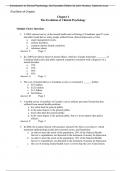Exam (elaborations)
Introduction to Clinical Psychology 3rd Canadian Edition By John Hunsley, Catherine Lee (Test Bank)
Course
Introduction to Clinical Psychology, 3rd Canadian
Institution
Introduction To Clinical Psychology, 3rd Canadian
Introduction to Clinical Psychology, 3rd Canadian Edition 3e John Hunsley, Catherine Lee (Test Bank)
Introduction to Clinical Psychology, 3rd Canadian Edition 3e John Hunsley, Catherine Lee (Test Bank)
[Show more]
Preview 4 out of 195 pages
Uploaded on
July 13, 2023
Number of pages
195
Written in
2022/2023
Type
Exam (elaborations)
Contains
Questions & answers
Institution
Introduction to Clinical Psychology, 3rd Canadian
Course
Introduction to Clinical Psychology, 3rd Canadian
$14.49
100% satisfaction guarantee
Immediately available after payment
Both online and in PDF
No strings attached
Chapter 1: The Evolution of Clinical Psychology Copyright 2014 © John Wiley & Sons Canada, Ltd. Chapter 1 The Evolution of Clinical Psychology Multiple Choice Questions 1. A 2003 national survey of the mental health and well -being of Canadians aged 15 years and older found that as many people suffered from clinical depression as from a. anger management issues. b. anxiety disorders. c. common chronic health conditions . d. substance abuse. Answer: C Page: 2 2. In a 2003 prevalence report of mental illness, Statistics Canada found that ________ of Canadian adolescents and adults report ed symptoms consistent with a di agnosis of a mental disorder. a. 10% b. 25% c. 50% d. 65% Answer: A Page: 2 3. The cost of mental illness to Canadia n society is estimated at _ _____ dollars. a. $57 million b. $121 million c. $1.5 billion d. $63 billion Answer: D Page 2 4. A health survey of members of Canada’s active military personnel found that they suffered from mental health problems a. less often than the general public . b. to the same degree as the general public . c. more often than the general public. d. to the same degree as the general public, but to a lesser degree than police officers. Answer: C Page: 2 5. In 2006, the London School of Economics released The Depression Report , which translated epidemiological data into economic terms , and found that: a. in order to meet the needs of the population, 20% of the National Health Service’s expenditures are allocated to the treatment of anxiety & depression . b. in order to meet the needs of the population, 10% of the National Health Service’s expenditures are allocated to the treatment of anxiety & depression. c. the cost of treating mental health issues is lower than the cost of prevention. (Introduction to Clinical Psychology, 3rd Canadian Edition 3e John Hunsley, Catherine Lee)




